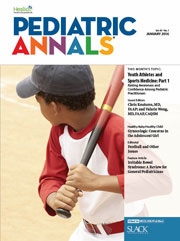Three Sports Medicine Articles Co-Edited by Dr Koutures in January, 2016 Pediatric Annals
Pleased to see publication of three outstanding articles on Reducing Cumulative Arm Overuse Injuries in Young Throwers, En Pointe Readiness, and EKG Screening in Athletes for the January, 2016 edition of Pediatric Annals. This Sports Medicine themed edition is the first of a 2 part series, with the second set of articles running in February, 2016.
Some of the following content may require a subscription to Pediatric Annals for full access.
Click here to access my Guest Editorial co-written by trusted friend and colleague Valarie Wong, MD
The discipline of pediatric sports medicine deals not just with musculoskeletal care, but rather encompasses a host of medical and orthopedic concerns to optimize safe and lifelong participation in sports and activities. Pediatric health care providers' well-known general medical and anticipatory guidance skills absolutely make them a natural and trusted part of the sports medicine team.
lick here to access the article: Reducing Cumulative Arm Overuse Injuries in Young Throwers by John Schlechter, DO
Overuse injuries are preventable when underlying contributors (GIRD, scapula dyskinesis) are addressed and enforced pitch counts are consistent with recommended limits. The single most important and modifiable risk factor in preventing injury in young throwers is activity modification and adequate rest periods prior to the onset of arm pain.
Click here to access the article: Assessing Readiness for En Pointe in Young Ballet Dancers by Jeffrey Lai, MD and David Kruse, MD
As with any medical evaluation, a proper history and physical examination are the first steps in assessing readiness for dancing en pointe. Age, years of dance training, and hours per week of training are important details to collect during the history, as are the ballerina's dance aspirations. Prior injuries, especially to the lumbar spine, hips, knees, feet, and ankles, should be recorded. The physical examination focuses on anatomy and flexibility, whereas functional assessments of technique, strength, and postural control also help determine pointe readiness
Click here to access the article: Use of Electrocardiogram as Part of the Preparticipation Exam by Kelly Chain, MD and Andrew Gregory, MD
Sudden cardiac death (SCD) is the leading cause of death in young athletes during sports participation. During preparticipation evaluation (PPE) visits, clinicians are receiving more questions about incorporating electrocardiogram (EKG) screening to detect potentially lethal heart conditions. Many families are aware that several countries in Europe routinely use EKG screening and wonder why the United States has not instituted this recommendation. What are the pros and cons of preparticipation EKG screening in the US, and how might athlete-specific criteria assist in reviewing EKGs conducted in young athletes?


